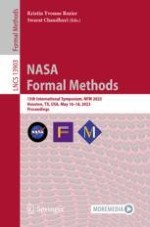2023 | Book
NASA Formal Methods
15th International Symposium, NFM 2023, Houston, TX, USA, May 16–18, 2023, Proceedings
Editors: Kristin Yvonne Rozier, Swarat Chaudhuri
Publisher: Springer Nature Switzerland
Book Series : Lecture Notes in Computer Science
